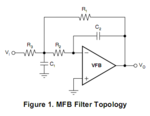lizardno1
Newbie level 5
i am working on some filter topologies,trying to figure out how these filters work.and in a TI's application report ,i find the MFB filter circuit

the Laplace transfer function given by the document is

however,the Laplace tranfer function derived by myself dosen't match the one above,and i'm really confused about it
My derivation:
step1:mark the voltage at the junction between R2 & R3 as Vt.Because Vp=Vn=gnd=0,so Vt/R2=-Vo/(1/sC2),Vt=-sC2*R2*Vo------Eq1
step2:according to KCL theory,(Vi-Vt)/R3=Vt/(1/sC1)+(Vt-Vo)/Rp,where Rp=R1//(R2+1/sC2)------Eq2
step3:solve Eq1 and Eq2 to get Vo/Vi
can anyone find which step of my derivation is wrong?thx a lot.

the Laplace transfer function given by the document is
however,the Laplace tranfer function derived by myself dosen't match the one above,and i'm really confused about it
My derivation:
step1:mark the voltage at the junction between R2 & R3 as Vt.Because Vp=Vn=gnd=0,so Vt/R2=-Vo/(1/sC2),Vt=-sC2*R2*Vo------Eq1
step2:according to KCL theory,(Vi-Vt)/R3=Vt/(1/sC1)+(Vt-Vo)/Rp,where Rp=R1//(R2+1/sC2)------Eq2
step3:solve Eq1 and Eq2 to get Vo/Vi
can anyone find which step of my derivation is wrong?thx a lot.
Last edited: